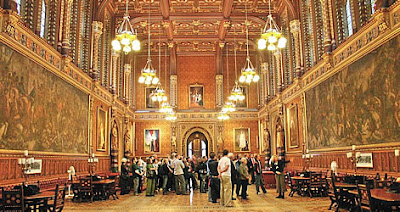The Royal Academy of Arts in London presents an exhibition of the restored cartoon for Daniel Maclise’s painting of “The Meeting of Wellington and Blucher” until January 3, 2016. The cartoon, a work on paper intended to be the pattern for a fresco in the House of Lords Gallery in Westminster Palace, was created by Maclise in 1858-59.
Conservation work on the Maclise Cartoon
After being in storage for many years, the cartoon was recently restored and to commemorate the 200th anniversary of the Battle of Waterloo, it is exhibited in the RA, Burlington House, Piccadilly. The completed work can be seen in the House of Lords Gallery, though it was changed from the original intention of creating a fresco to a glass painting. More about that below.
For all the details of the conservation and the exhibition, click here.
For more details from the Daily Telegraph, click here.
The Guardian’s take is here.
The completed painting in the House of Lords Gallery
Maclise was a well known historical painter and was chosen to decorate the walls of Westminster with frescoes. After he completed the cartoon, he found the process of painting in plaster unsuitable for the work. With the cooperation of many governmental leaders, including Queen Victoria’s husband, Prince Albert, Maclise mastered a newer technique of water-glass painting, by which the work was completed.
Royal Gallery, Palace of Westminster, Waterloo Mural on the left
The completed cartoon is about 45 by 12 feet in size. It depicts the moment in the evening of June 18, 1815, when the two generals who were victorious in defeating the French armies of Napoleon met at the Inn of La Belle Alliance. They shook hands and conferred on their next steps to pursue the French. On the opposite wall of the Gallery in Westminster Palace is the similarly sized portrayal of the Death of Nelson, also by Maclise.
Daniel Maclise (1806-1870)
1857 lithograph by Charles Baugnet
From the RA description: “Maclise was a prolific painter and illustrator who was much admired for his draughtsmanship and his outstanding skill is showcased in the Waterloo Cartoon. Completed from 1858–1859 he used extensive research and eye-witness accounts to inform the work. Remarkably the piece does not portray triumphalism or glorify war, instead highlighting the tragedy and suffering of this ferocious battle. The cartoon has recently undergone conservation treatment, thanks to funding from the Arts Council England, to allow it to be presented during this significant occasion.
Detail of Blucher and Wellington shaking hands
The level of detail in the cartoon can be best seen in the individual panels, of which there are ten on display. The figures are life-size.
Of you are fortunate enough to be in London in the next few months, don;’t miss the RA’s exhibition of the Maclise Waterloo Cartoon. Victoria and Kristine envy your good lick!!






